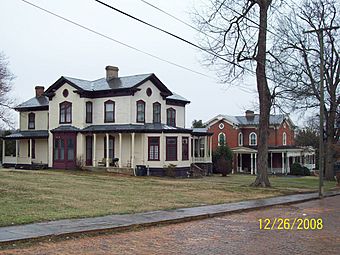Daniel's Hill Historic District facts for kids
|
Daniel's Hill Historic District
|
|
 |
|
| Location | Cabell, Norwood, Hancock, Stonewall from 6th to H St., Lynchburg, Virginia |
|---|---|
| Area | 49 acres (20 ha) |
| Architectural style | Late 19th And 20th Century Revivals, Late Victorian |
| NRHP reference No. | 83003289 |
Quick facts for kids Significant dates |
|
| Added to NRHP | February 24, 1983 |
The Daniel's Hill Historic District is a special area in Lynchburg, Virginia. It's recognized for its important history and beautiful old buildings. This district is like a preserved neighborhood, showing how people lived long ago.
Contents
History of Daniel's Hill
The Daniel's Hill area is named after two important judges, both named William Daniel. The first William Daniel inherited a large piece of land. This land included a grand house called Point of Honor. This house was built around 1815 in a style called Federal.
How the Land Became a Neighborhood
After the first William Daniel passed away in 1839, his son, William Daniel, Jr., inherited the land. He was also a famous judge. In the mid-1840s, Judge Daniel Jr. divided his large land into smaller pieces. This made it possible for new streets and houses to be built.
Judge Daniel Jr. later built a new mansion nearby called Rivermont. This shows how the area was growing.
Important People and Homes
Over time, other important people moved to Daniel's Hill. For example, Robert L. Owen Sr., who was the president of a railroad, lived at Point of Honor. His son, Robert L. Owen Jr., later became a U.S. Senator.
Many grand houses were built on Cabell Street, which runs along the top of Daniel's Hill. These homes started appearing in the 1850s.
Work and Life on the Hill
At the bottom of the hill, there were large buildings called tobacco warehouses. These were places where tobacco was stored. There were also homes for the workers on the side streets. Managers and professionals lived higher up on the hill.
After the American Civil War, these warehouses became part of the Lynchburg Tobacco Works. A factory that made tin and iron goods also opened. These businesses provided many jobs for people living in the neighborhood.
Famous Buildings and Architects
One interesting story is about a house at 405 Cabell Street. A man named Albert Gallatin Dabney bought land in 1848 and built this house by 1853. But he had to sell it soon after. People called it "Dabney's Folly." Later, a family bought it and made it beautiful again.
Local architects also designed many homes here. Robert C. Burkholder built his own home on Cabell Street and designed other Victorian-style buildings. Another architect, Carrington Hubbard, designed a mansion at 214 Cabell Street. You can see different styles of homes here, like Georgian, Queen Anne, and Italianate.
Community Life and Churches
Daniel's Hill didn't have many shops, but it had several small churches. These included C Street Baptist Church and First Christian Church. Christ Episcopal Church was built in 1876. Later, it was sold and became a neighborhood grocery store. These churches were important gathering places for the community.
Geography of Daniel's Hill
The Daniel's Hill Historic District is located on a long, narrow hill. The James River is on one side, and Blackwater Creek is on the other. This hill has very steep sides. It's right next to central Lynchburg.
What You'll Find in the District
The district covers about 21 city blocks. It has around 180 buildings. Most of these are houses built between the early 1800s and the early 1900s. You can see many different architectural styles here. These range from the early Federal style to the later Georgian Revival style. There are also many regular homes built in a local style.
Along Cabell Street, which is the main road, you'll find many impressive mansions. Most of these grand homes were built in the second half of the 1800s. Point of Honor is one of these famous mansions.
The Daniel's Hill Historic District was added to the National Register of Historic Places in 1983. This means it's a very important historical area.



